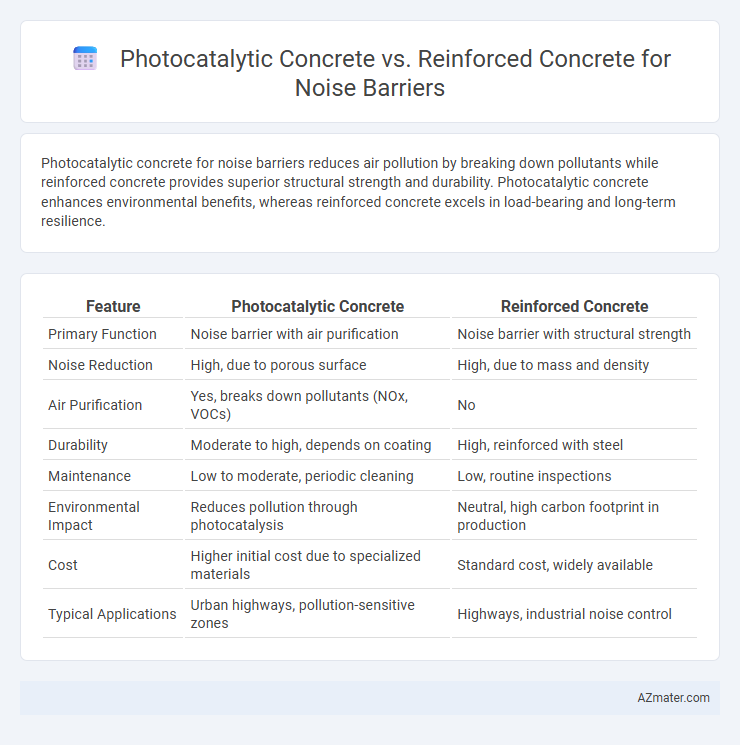Photocatalytic concrete for noise barriers reduces air pollution by breaking down pollutants while reinforced concrete provides superior structural strength and durability. Photocatalytic concrete enhances environmental benefits, whereas reinforced concrete excels in load-bearing and long-term resilience.
Table of Comparison
| Feature | Photocatalytic Concrete | Reinforced Concrete |
|---|---|---|
| Primary Function | Noise barrier with air purification | Noise barrier with structural strength |
| Noise Reduction | High, due to porous surface | High, due to mass and density |
| Air Purification | Yes, breaks down pollutants (NOx, VOCs) | No |
| Durability | Moderate to high, depends on coating | High, reinforced with steel |
| Maintenance | Low to moderate, periodic cleaning | Low, routine inspections |
| Environmental Impact | Reduces pollution through photocatalysis | Neutral, high carbon footprint in production |
| Cost | Higher initial cost due to specialized materials | Standard cost, widely available |
| Typical Applications | Urban highways, pollution-sensitive zones | Highways, industrial noise control |
Introduction: The Evolution of Noise Barrier Materials
Photocatalytic concrete and reinforced concrete represent significant advancements in noise barrier materials, with photocatalytic concrete integrating titanium dioxide to actively reduce pollutants and enhance environmental quality. Reinforced concrete provides exceptional structural strength and durability, making it a traditional choice for noise barriers along highways and urban areas. The evolution from solely structural materials to multifunctional surfaces highlights the growing emphasis on sustainability and air quality improvement in noise barrier design.
Understanding Photocatalytic Concrete Technology
Photocatalytic concrete integrates titanium dioxide (TiO2) nanoparticles that activate under UV light to break down airborne pollutants, enhancing air quality near noise barriers. Unlike conventional reinforced concrete, this technology not only provides structural strength but also offers environmental benefits by reducing nitrogen oxides (NOx) and other harmful emissions. The self-cleaning and pollution-removing properties of photocatalytic concrete make it an innovative solution for sustainable noise barrier construction.
Reinforced Concrete: Traditional Choice in Noise Barriers
Reinforced concrete remains the traditional choice for noise barriers due to its superior structural strength and durability, effectively absorbing and deflecting sound waves in urban and highway settings. Its high density and rigid framework enable long-term resistance against weathering and mechanical damage, ensuring reliable noise reduction over decades. Compared to photocatalytic concrete, reinforced concrete offers established engineering performance with proven cost-efficiency and minimal maintenance requirements.
Comparative Structural Durability and Performance
Photocatalytic concrete incorporates titanium dioxide to actively reduce air pollutants, enhancing environmental performance but exhibiting slightly lower compressive strength compared to conventional reinforced concrete, which is engineered with steel rebar to provide superior load-bearing capacity and structural durability. Reinforced concrete noise barriers demonstrate higher resistance to tensile stress and long-term cracking, essential for withstanding dynamic wind and traffic-induced vibrations, whereas photocatalytic concrete offers surface self-cleaning properties that maintain barrier aesthetics and mitigate pollution over time. The choice depends on prioritizing environmental benefits and surface maintenance versus enhanced mechanical strength and structural resilience under harsh weather conditions.
Noise Reduction Effectiveness: Photocatalytic vs. Reinforced Concrete
Photocatalytic concrete enhances noise reduction by leveraging its porous surface and photocatalytic properties that break down airborne pollutants and reduce sound wave reflection. Reinforced concrete provides a denser, more solid barrier that effectively blocks and absorbs sound waves through mass and rigidity. Comparative studies indicate photocatalytic concrete may offer superior noise diffusion and pollutant degradation, while reinforced concrete excels in direct sound insulation and structural durability for noise barriers.
Environmental Impact and Sustainability Benefits
Photocatalytic concrete incorporates titanium dioxide, which actively breaks down air pollutants, reducing smog and improving urban air quality compared to traditional reinforced concrete. Its self-cleaning properties minimize maintenance needs, lowering lifecycle environmental footprints associated with cleaning chemicals and operations. Reinforced concrete, while structurally strong, lacks pollutant-degrading capabilities, making photocatalytic concrete a more sustainable choice for noise barriers in environmentally sensitive areas.
Maintenance Requirements and Longevity
Photocatalytic concrete used in noise barriers offers self-cleaning properties due to titanium dioxide additives, reducing maintenance frequency by breaking down pollutants on the surface. Reinforced concrete noise barriers require regular inspections and maintenance to address issues like corrosion of steel reinforcements and surface wear. The longevity of photocatalytic concrete can exceed that of conventional reinforced concrete by maintaining structural integrity and aesthetic appearance with less maintenance over time.
Cost Analysis: Installation and Lifecycle Expenses
Photocatalytic concrete noise barriers typically incur higher initial installation costs due to advanced material synthesis and specialized coatings compared to reinforced concrete, which uses conventional materials and construction techniques. Lifecycle expenses for photocatalytic concrete are reduced by its self-cleaning property and pollutant-reducing effect, leading to lower maintenance and cleaning costs than reinforced concrete barriers, which often require periodic surface treatments and repairs. Cost-benefit analysis reveals that though photocatalytic concrete demands greater upfront investment, its extended durability and environmental benefits provide long-term economic advantages in urban noise barrier applications.
Real-world Case Studies and Applications
Photocatalytic concrete has demonstrated significant effectiveness in reducing air pollution and noise levels in urban noise barriers, as seen in Tokyo's Shuto Expressway project where titanium dioxide-treated surfaces degraded airborne pollutants while dampening traffic noise. Reinforced concrete remains the standard for noise barriers due to its structural durability and high sound attenuation, exemplified by the I-15 highway barriers in Utah, which effectively reduce highway noise for nearby residential areas. Comparative real-world applications reveal photocatalytic concrete offers environmental benefits alongside noise reduction, whereas reinforced concrete excels in load-bearing strength and long-term acoustic performance.
Future Prospects in Noise Barrier Innovation
Photocatalytic concrete offers future prospects in noise barrier innovation by combining sound absorption with air purification properties, reducing urban pollution alongside noise pollution. Reinforced concrete remains key for structural strength and durability, but integrating photocatalytic materials can enhance environmental benefits without compromising mechanical performance. Advancements in nanotechnology and material science are expected to optimize photocatalytic efficiency, making noise barriers multifunctional solutions for sustainable urban infrastructure.

Infographic: Photocatalytic concrete vs Reinforced concrete for Noise barrier
 azmater.com
azmater.com